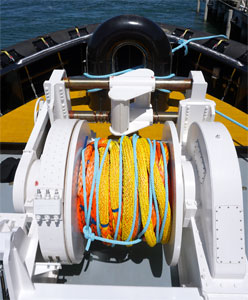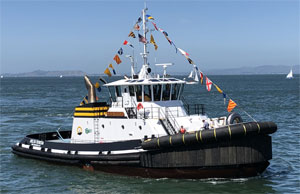Capt. Mike Harbarth steered Delta Teresa away from San Francisco’s Pier 17 and headed east. He slowed the new diesel-electric hybrid to a crawl as a sailboat or two clambered past. Then he started showing off.
The gleaming tugboat spun clockwise and counterclockwise as nearly 100 people snapped pictures from shore. Most significant of all, the vessel performed these maneuvers without its main engines.
Delta Teresa, named for the wife of Peter Zwart, Baydelta Maritime’s late vice president of operations, is the first tractor tugboat in the world with Rolls-Royce (now Kongsberg) diesel-electric propulsion. Captains can run the vessel using electric motors powered by up to four Caterpillar gensets or using just the twin 2,650-hp Cat 3516 Tier 3 main engines. Both systems can run simultaneously for maximum power. Bollard pull exceeds 90 tons, while the electric engines alone deliver 22 tons. There is no hybrid battery storage on board.
Jensen Maritime Consultants provided plans for the 100-by-40-foot tugboat. The design is a replica of the six other Valor-class tugboats Baydelta has built since 2006. Nichols Brothers Boat Builders of Whidbey Island, Wash., delivered the vessel in mid-April.
 |
|
Delta Teresa captains can switch between propulsion modes with the touch of a button. |
Shawn Bennett, Baydelta’s CEO, expects myriad benefits from the hybrid system, including lower emissions, fuel consumption and maintenance costs. There are less obvious advantages too, like the ultra-responsive electric motors driving the Rolls-Royce z-drives. These motors also allow greater control at low speeds and the ability to turn the props as slowly as 1 rpm.
“There is not one silver bullet,” Bennett said of the hybrid system. “But there are a collection of benefits we expect to see over time.”
Baydelta tugs primarily escort and assist tankers to and from refineries north of San Francisco. For this task, the company runs its Valor-class tractor tugs with powerful mains, stout winches and robust skegs. The vessels are optimized for indirect towing, ship docking and stopping tankers in an emergency.
The company’s tugs typically meet inbound tankers west of the Golden Gate Bridge, roughly seven miles from San Francisco’s Pier 17. Escorts can exceed 25 miles depending on the destination, and after docking the tugs typically return to their home pier across the Bay. That means Baydelta tugs spend a lot of time traveling light. That operating profile is a good fit for the Rolls-Royce hybrid propulsion installed aboard Delta Teresa, Bennett said.
 |
|
Baydelta President Shawn Bennett, left, and commercial director Ralph Silverman stand alongside the Rapp stern winch. |
Nichols Brothers started steel work on Delta Teresa in 2015 before the deadline to install Tier 4 engines. Soon afterward, Baydelta hit pause to oversee construction of Caden Foss, which is owned by a sister company and chartered by Foss Maritime in San Francisco Bay. The break also allowed Rolls-Royce to fine-tune its hybrid package, Bennett said.
Baydelta did not seriously consider installing a battery-electric hybrid system, despite advances in battery technology since Foss built Carolyn Dorothy a decade ago.
“The heat containment would have been … challenging with the size of the batteries,” according to Bennett. “Power storage in the future would be great, but right now it was not a risk we could take.”
Delta Teresa utilizes four generators for electrical power. The three largest units, installed in a row forward of the Cat 3516s, are Cat C9.3 gensets capable of 300 kW each. A single 150-kW Cat C7.1 genset can provide shipboard power or feed the hybrid system for extra boost. Current from all four generators can power Marelli Motori electric motors installed aft of the Rolls-Royce 255 FP z-drives.
Four operational modes are available to the captain. In electric mode, the mains are idle while the gensets supply current to the electric z-drive motors. Depending on how much thrust is required, anywhere from one to all three gensets provide electrical power. The tug can reach 9 knots in hybrid mode, Harbarth said.
 |
|
Marelli Motori electric thruster motors work separately or in tandem with the main engines depending on power demands. |
Delta Teresa can run conventionally with the main engines turning the z-drives through Centa carbon-fiber shafts. “Boost” mode supplies power from the mains and electric motors, and “boost plus” mode also sends current from the fourth genset to the z-drive motors.
Delta Teresa matches other Valor-class vessels in the fleet for power, stability and stopping power. But the Marelli motors provide a distinct advantage over traditional z-drive propulsion. Instead of getting roughly 500 engine rpm and more than 100 prop rpm upon clutching the mains into gear, the electric motors can turn the props as slowly as 1 rpm. This gives the captains greater control when jobs require it, and creates smaller wakes and less prop wash when working in sensitive areas.
“That puts this boat into a whole different class,” Harbarth said. “When we are doing finesse-type work, we can really finesse with this tug.”
Although the tug’s Tier 3 Cat mains lack the urea-based aftertreatment system found in newer Tier 4 models, Bennett said Delta Teresa still has clear emissions reductions from the hybrid system. He expects less NOx and SOx compared to standard Tier 3 propulsion — two important factors in environmentally conscious California.
 |
|
Delta Teresa is the first Baydelta tugboat with Rapp Marine winches. The single-drum AHTW-50E stores about 1,200 feet of 2-inch line. |
The “brains” of the hybrid system reside in two liquid-cooled, dust-free cabinets aft of the main engines. The technology automatically activates additional generators as the operator requests more power. It balances loads on each generator when more than one are running. Touch-screen displays offer full control over the propulsion system.
Another corner of the engine room has a touch-screen engine control panel. The system displays oil pressure, engine temperature and numerous other data points. It can track alerts and alarms over time. Taken together, the system offers a clear picture of the vessel’s mechanical performance. That will help engineering crews respond to any issues as they arise.
“It will steer me in the right direction, definitely,” said Paul Terrell, one of the engineers. “It is a lot better than just a little red light.”
There aren’t many tugboats that could add two engines — never mind the new electronic components and cabinets — to the engine room without sacrificing storage, work space, or both. Jensen’s Valor class is an exception.
“One of the things the Valor-class tugs always had going for (them) is a very large engine room,” said Jonathan Parrott, Jensen’s senior naval architect. “It’s long, it’s wide and it’s very tall. … There is plenty of space, even with the extra generators.”
 |
|
Delta Teresa’s spacious engine room and touch-screen engine control panel make engineer Paul Terrell’s work a little easier. |
The hybrid system still required several changes to engine room design and layout. The main engines are elevated to allow a straight shaft between the engines and z-drives, which are about 12 inches forward compared to those of its sister tugs. Notches were cut into the stern tanks to accommodate the electric motors aft of the z-drives.
“The redesign was done to minimize the changes, and those changes were overall pretty minor,” Parrott said. “This design can be (tweaked) pretty easily. It has a lot of capability in it.”
Nichols Brothers has plenty of experience building Valor-class tugboats. With Delta Teresa, it has built seven for Baydelta, marking the largest series for one customer in the yard’s history.
“This is the first time ever we have delivered that many of one type to one customer. We are very thankful,” said Matt Nichols, the yard’s executive vice president.
Delta Teresa is the first tugboat in the Baydelta fleet with Rapp Marine winches. Rapp, now owned by MacGregor, supplied a newly designed Rapp HA-75E bow hawser winch with a liquid-cooled, 100-hp electric motor. It can pull 16 tons and has a brake holding strength of 300 tons at the barrel level. It can store more than 800 feet of 8-inch line.
 |
|
Electrical power on Delta Teresa comes from three 300-kW Cat C9.3 gensets installed in a row forward of the main engines. A fourth C7.1 unit also can supply the hybrid system. |
“This hawser winch will incorporate Rapp Marine’s proprietary fluid-cooled electric motor, commonly used on Rapp Marine’s advanced winches for fisheries and research applications,” said Johann Sigurjonsson, president of Rapp Marine. “That allows continuous, high-torque operation on the electric motor without overheating, while maintaining a compact footprint.”
Delta Teresa’s aft deck has a Rapp AHTW-50E single drum, which will store about 1,200 feet of 2-inch synthetic rope. The winch can pull over 75 tons at first layer, and utilizes pneumatic cylinders in place of hydraulics. The robust brake offers a force of 205 metric tons on the barrel layer.
“Both winches are equipped with level winds and multidisc clutches that will disengage the drum from the drive line for either routine operations or in the event of an emergency freewheel/release situation,” Sigurjonsson said.
The interior layout with Delta Teresa mirrors other Baydelta tugs. The main deck has a well-appointed galley and spacious mess with seating for eight people. An adjacent lounge with cable TV has three leather recliners, giving crew a place to relax during downtime. The captain’s single bunk is on the main level along with a double bunk across the hall. Two more double bunks are located down below, forward of the engine room.
 |
|
Rapp Marine’s HA-75E hawser winch features a fluid-cooled electric motor that can run continuously in high-torque operations without overheating. |
Baydelta crews live aboard the tug during hitches that last up to two weeks. Crew amenities include individual climate control in each stateroom and wireless Internet throughout the vessel. Poured floors in the cabins, resilient-mounted engines and the carbon-fiber shaft reduce engine noise and vibration.
The wheelhouse has the same 360-degree views as other Valor-class tugs with modern Furuno navigation electronics, Simrad autopilot and Icom radios. Perched in a SeaPost helm chair, captains also have a control panel for the hybrid system with push-button toggling between propulsion modes. Additional seating was incorporated into the console on the port and starboard sides of the wheelhouse.
Given the proven performance of the existing Valor-class tugs, Bennett admits occasional bouts of wariness about the new hybrid propulsion package. He recalled touring the engine room before delivery and seeing six laptop computers open “and not a wrench to be found.” But successful sea trials put many of those concerns to rest.
“This is the first of a kind,” he said. “So there are little kinks we’ll be working out, but I am really looking forward to seeing how she runs and seeing how she operates.”

